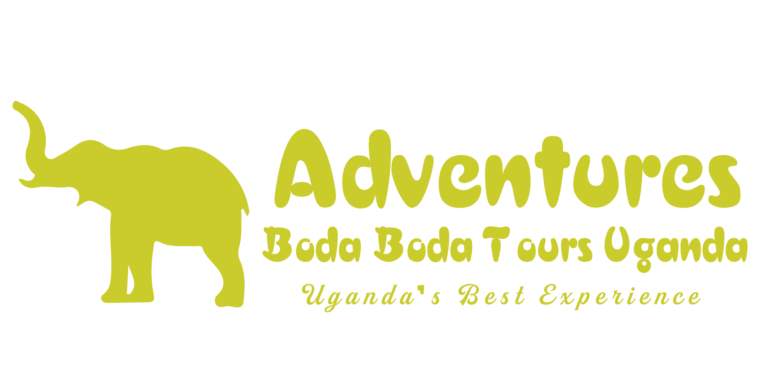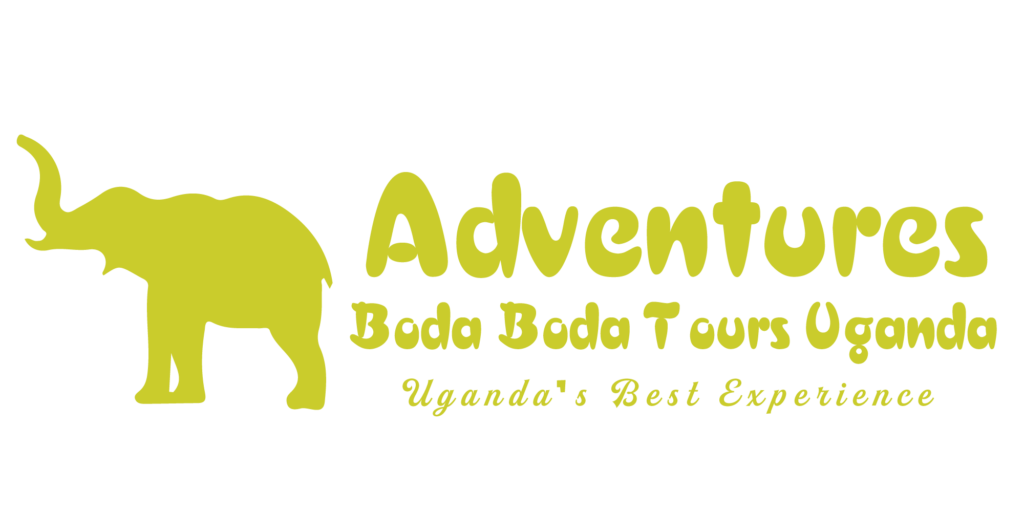
Uganda has a total of over 350 species of mammals of all sizes and more than 1000 bird species living in its parks and game reserves making the number of Wild Animals impressive for those who come on our Uganda Safaris Tours and making it really difficult to fully answer the question of what animals should you expect to see on your Uganda Wildlife Safari.
Uganda enjoys a perfect Weather for the Best Wildlife Adventures throughout the year with a tropical climate that’s ideal for Game Viewing. With a variety of tree species, Plant life, beautiful landscapes and abundant wildlife including the great Apes; Mountain Gorillas and Chimpanzees as well as the Big 5; Lion, Leopard, Elephant, Giraffe, and Rhinoceros . You can as well read our blog WHERE TO GO ON A SAFARI IN UGANDA.
Uganda’s Mammals range from large (like Mountain gorillas, rhinoceros, buffaloes, lions, and elephants) to small (like bats, bush babies, and shrews).
The list of Animals expected to see while on a Uganda Safari is Long, However below is a list of some of the top animals that you can expect to see while on a Uganda Adventure Safari Game viewing drive. Some of these Amazing Animals keep hiding most of the time while others are common sight to Ugandans
1. Mountain Gorilla.

The mountain gorilla (Gorilla beringei beringei) is a subspecies of the eastern gorilla and is the Biggest of the great apes. Over half of the world’s population of around 750, live in Uganda’s Bwindi Impenetrable and Mgahinga National Park areas. Mountain gorillas can’t survive in captivity, so it is vital to protect their habitat with a life span of about 50 years and in captivity they may live less than 35 years. They live in close family groups of about 30 members led by a silverback or mature male. Gorillas are Humble and rarely attack humans, but in an encounter a person should stay still and refrain from staring or pointing at the Gorilla. Gorillas are purely vegetarian with mainly leaves, buds, shoots, tubes, roots, stalks, bark, fruits ferns
Mountain Gorillas are among the More Popular attractions for a Uganda Safari as a hike through the lush and dense Forests to encounter with these Mountain Gorillas is a moving Experience and the Hours spent watching these Gentle giants going about their day is an encounter worth it.
2. Golden Monkey.
Golden monkeys (Cercopithecus kandti) are another endangered primate species as rare as the mountain gorillas. Golden Monkeys are a subspecies of the blue monkey that can only be found in the foothills of the volcanic Virunga Mountains that extends through Uganda, Rwanda and the Democratic Republic of the Congo. The golden monkey has golden fur on its body, tail and cheeks, but its limbs are black. It weighs between 10 and fifteen pounds
Unlike mountain gorillas which can be seen in the two parks of Uganda (Bwindi National Park and Mgahinga Gorilla National Park), Golden monkeys in Uganda are only found in Mgahinga Gorilla National Park. They are very playful and always flying around the various branches – which puts on quite the show.
3. African Elephants.

The African Savannah Elephant (Loxodonta africana) is the Largest living Land mammal and a large male can stand 13 feet tall and weigh up to 6,000 kilograms, while an average-sized male stands around 10.5 feet tall and weighs 6.6 tons. Females are notably smaller. An elephant is one of the classic African Safari animal and seeing one up close is a revealing moment for how big it really is.
There are two types of African Elephants, the massive African bush Savannah elephants and the smaller (3000 Kg) African forest elephants with downward-facing tusks. Elephants live in areas with adequate quantities of grass and water, with a diet consisting of grass, leaves, twigs, bark, fruit and seed pods.
The best place for elephants is Queen Elizabeth National Park, where both the bush and forest species can be found. One can also get to see them close during the Kazinga launch cruise and Kidepo Valley National Park. Kibale National Park is also Home to many African Forest Elephants.
The African bush elephant or African Savannah elephant is an impressive sight; Big game hunters counted elephants among the “Big Five,” those animals that were most dangerous to hunt on foot. Nowadays, seeing an elephant in the wild is on every traveler’s wish list of Uganda animals to see. For their size, elephants can move surprisingly fast. Elephants can also be seen while on your Murchison Falls National Park Safari
4. African Lion.

The lion (Panthera leo) is one of Africa’s Big Five and the largest member of the cat Family that shouldn’t miss on your on your wish list of Uganda animals in the country’s National Parks.
Lions are top predators living in an eco-System and are the most social of the big cats and live in family groups called prides of 5- 15 that consist of several related females that live with the pride for life, their cubs, and one or two adult males. The cubs are generally born around the same time, and the lionesses take turns babysitting them. The lionesses do most of the hunting, and they usually target big game like giraffes or buffaloes. The male’s job is protecting the pride from enemies. Lions have a Mane while the lionesses do not. Lions can mainly be seen while on your game safari to Murchison Falls National Park, Queen Elizabeth National Park and Kidepo National Park.
5. Antelopes

Uganda is home to an impressive 29 species of antelope, including the eland – the world’s largest antelope, which can measure up to 180cm at the shoulder!
Other large species include the greater kudu, which has long, elegant spiral horns and white side stripes; Jackson’s hartebeest – an unusual, flat-faced creature found only in Uganda, and the shaggy waterbuck – often found near rivers and lakes, as their name suggests.
The Eland is the world’s largest antelope species and can be found in only two of Uganda’s National Parks; Lake Mburo National Park and Kidepo Valley National Park.
Mature Elands can weigh up to 900 Kgs and are said to produce milk that has better milk fat than a cow’s milk.
Elands are fawn-colored, with white vertical stripes on their bodies. A distinctive characteristic of the eland is a black dewlap (flap of skin between the throat and chest). Males have twisted horns which are thick and tightly spiraled, growing up to 25″ in females and to 50″ in males. Eland belong to the same group as kudus, nyala and bushbuck. Eland are found in grassland, mountain, sub-desert, acacia Savannah and woodland areas.
Fascinating yet rarely seen is the semi-aquatic sitatunga – Swamp antelope, whose splayed hooves are adapted for life in the papyrus swamps. The sitatunga (Tragelaphus spekii) is a semi-aquatic antelope that lives in swamps. Its splayed feet help it swim. Males are larger than females and can weigh up to 275 pounds and be as much as 63 inches long. A frightened sitatunga will retreat into deep water so that only its nostrils are visible. Much more common are Grant’s gazelle, which can live in herds of hundreds of individuals.
The Uganda kob (Kobus kob thomasi) is a type of Antelope that appears on the Uganda Coat of Arms as Uganda’s National Animal as well as on the Uganda wildlife emblem because they signify the abundance of wildlife in Uganda. Kobs are common in most of Uganda’s National parks and live in grasslands near water bodies. They will most likely be the first animals to welcome you to Uganda’s Savannah wildernesses.
Waterbucks have to stay within several miles of water so that they can easily drink every 1 or 2 days. Having a preference for grasslands, waterbucks graze on firm ground generally found next to woodlands. Waterbucks typically graze on medium and short grasses which are good sources of protein. When grass is not abundant, herbs and foliage seem to be their second choice.
The Impala is the most common and widespread antelope on the savannas and woodlands of east and southern Africa and live in Savanna woodland where water is available. An extremely adaptable species, impalas’ food is varied. They are intermediate feeders (browsers and grazers), depending on the area they inhabit and the availability of food. In many areas impala are the most common source of food for predators.
In Uganda, impalas are found only in Lake Mburo National Park and Katonga Wildlife Reserve but have been recently reintroduced in Pain Upe Game Reserve.
The impala can be distinguished from any gazelle by its chestnut coloring, sleek appearance and the male’s distinctive lyre-shaped horns. An adult impala can jump up to 3m high and has been known to broad-jump for over 10m.They favor well-wooded savanna and woodland fringes, and are often abundant in such habitats. Antelopes make up a goodly portion of the Uganda wildlife, Males can weigh around 200 pounds, while females are significantly smaller at 130 to 140 pounds.
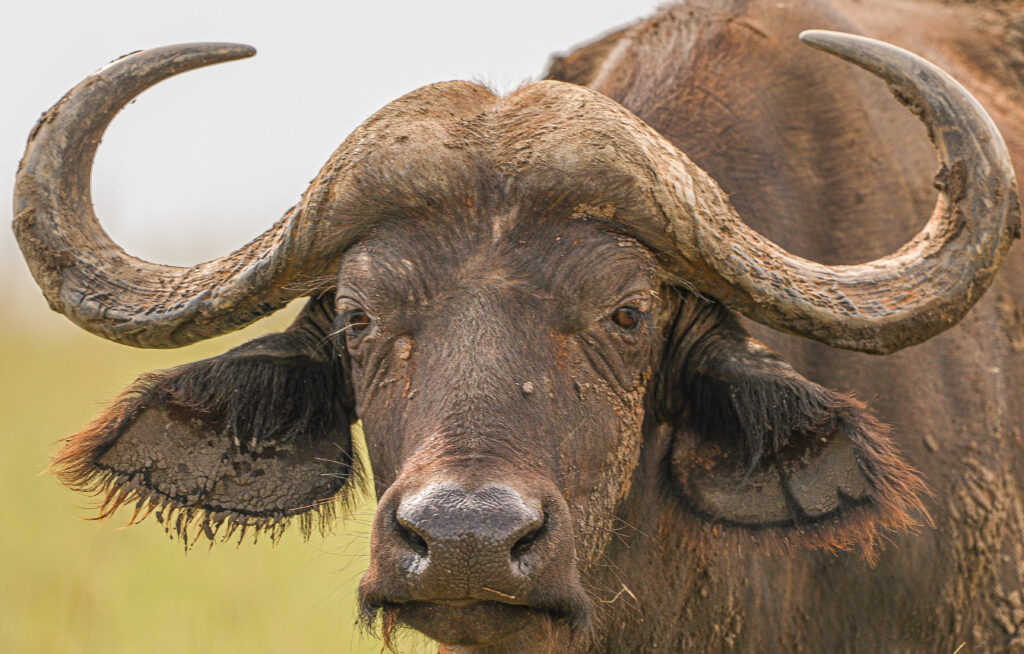
6. Cape Buffalo.
The Cape buffalo (Syncerus caffer), is a member of the Big Five, It is unpredictable and can be dangerous if wounded. It has killed more big game hunters than the other four animals of the Big Five Family put together. When it’s threatened it doesn’t back off. Instead, it becomes aggressive. The buffalo can chase a person or animal reaching a speed of 30 miles per hour. Not as fast as the world champion Cheetah but it is still very fast. In fact Buffalos kill more people in Africa than lions. A Buffalo is a subspecies of the African buffalo, the only bovine in Africa. Both males and females have horns, and the horns on a big male can be four feet across. A large male can weigh nearly a ton and stand six feet tall at the shoulder. Despite their aggression, Cape buffalo live in herds that can contain hundreds or thousands of animals.
Cape buffalos look for habitats Close to water bodies. They have poor ability to regulate body temperature so they remain in shade in the heat of day or wallow in mad. Murchison Falls National Park, Queen Elizabeth National Park Lake Mburo National Park in Uganda are places to see the African Buffalo.
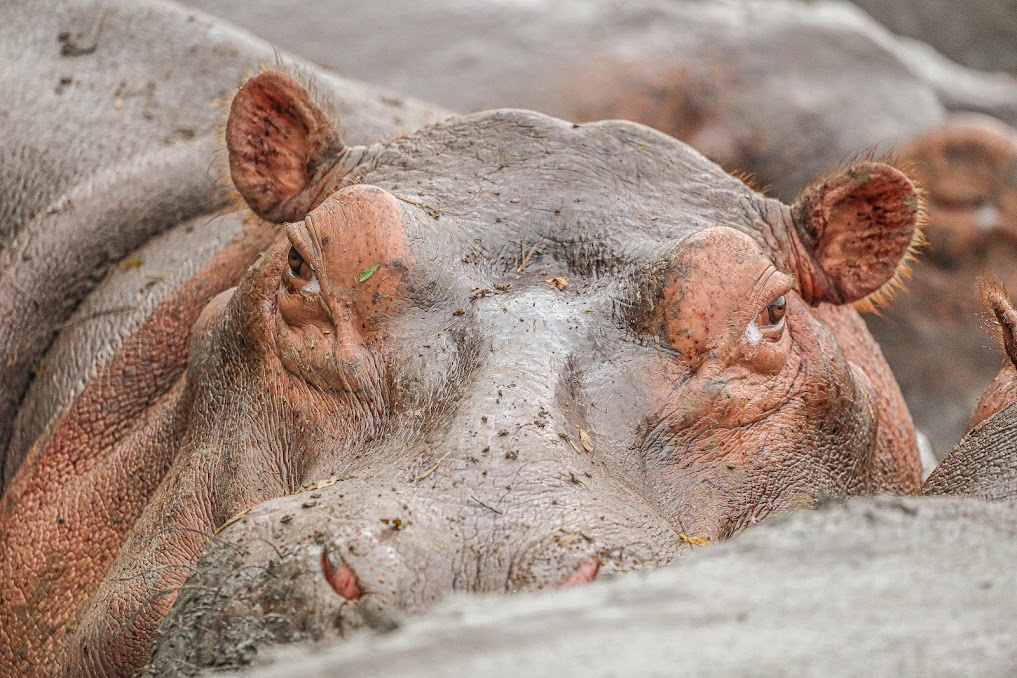
7. Hippopotamus.
The hippopotamus (Hippopotamus amphibious) is one of the animals’ native to Uganda. The word “hippopotamus” comes from the Greek for “river horse,” and it ironically, is more closely related to whales and dolphins than it is to horses.
After the elephant the great African Hippopotamus is second in weight, weighing up to 5 tons. Hippopotami have no sweat glands but have unique glands that produce a red fluid hence a myth that Hippos sweat blood. Hippopotami spend a lot of time in water to cool off. They can remain completely submerged for six minutes before needing to come up for air. They usually come out of Water in the Night to feed. At first glance, hippos look fairly harmless. But these are powerful animals with jaws strong enough to break a canoe in half. When these animals stampede they can trample anything in their path. There are approximately 500 people killed each year in Africa by this large mammal.
Hippos live in rivers, lakes, and swampy areas surrounded by grass. Hippos can be seen in Lake Mburo National Park, near the Ntungwe River in Queen Elizabeth National Park, Kafu basin as well as near the Nile River in Murchison Falls National Park in Uganda.
8. Leopard.
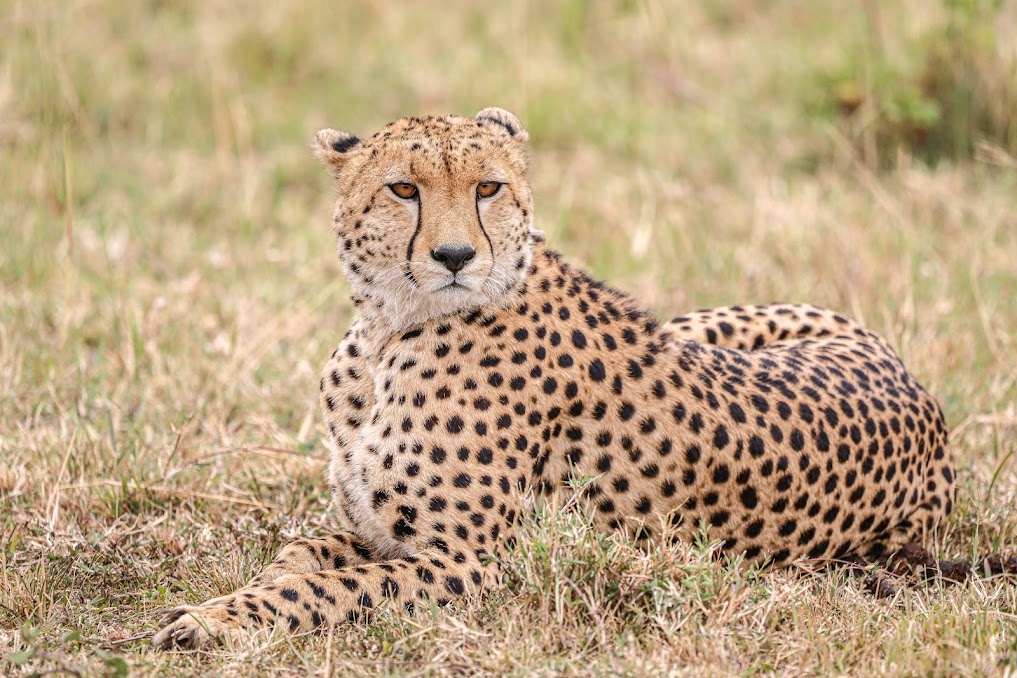
The African leopard (Panthera pardus pardus) is secretive, shrewd and the most elusive member of the Big Five. It is the master of Camouflage for its spotted coat allows it to blend in with its surroundings. It is a Cunning and stealthy hunter.
The leopard is also the most arboreal of the big cats, and it is strong enough to haul its prey up a tree, so it can leisurely eat it without being robbed by hyenas or lions. Leopards are also skilled swimmers, they can jump up to ten feet in the air, and can run up to 35 miles per hour. The habitat for a leopard includes savanna and forest areas of Uganda and can be spotted in Murchison Falls National Park, Queen Elizabeth National Park, Kidepo Valley National Park and Lake Mburo National Park. Many people have it on their most-desired Uganda animal list, however these creatures are very solitary go out of their way to avoid one another. If you get an opportunity to find them, count your blessing as they spend most of the time hidden in trees, caves and hunt at night and spend the day strolling through the Savannah and Forests. Males are 50% Larger than Females. They don’t roar but Purr.

9. Giraffe.
Uganda is home to one of the most threatened subspecies of giraffe: the Nubian giraffe (Giraffa Camelopardalis) formerly known as Rothschild giraffe and is now one of the most endangered giraffe species only a few hundred still live in the wild. It is also the tallest of the giraffes and can reach a height of 19 feet Even a newborn giraffe stands as tall as man! When startled, a Giraffe can gallop at speeds up to 56 Mph. because Giraffe have a good sense of smell and vision, other animals stay close to them, since they can see predators afar.
A Giraffe has one of the shortest sleep requirements of any mammal, 20 Minutes to two hours in a 24 hour period. To avoid predators, Giraffes sleep while standing up.
A giraffe diet is leaves and shrubs and can eat 60kgs of leaves and twigs daily and can go for a month without drinking because of vulnerable position they must assume in order to drink. This is the reason they do not graze on grass.
The Nubian giraffe has been largely eliminated from much of its former range and the Nubian giraffe conservation in Uganda is an important programme for its Conservation and is currently focusing on three national parks that host giraffe, namely Murchison Falls (northern and southern bank), Kidepo Valley and Lake Mburo National Parks, as well as Pian Upe Game Reserve, where giraffe were reintroduced in 2019. . Rothschild giraffes can only be found in Kenya and Uganda – with Uganda having the biggest population. A giraffe is one of the ‘big five’ safari animals and therefore deserves to be on your wildlife checklist.
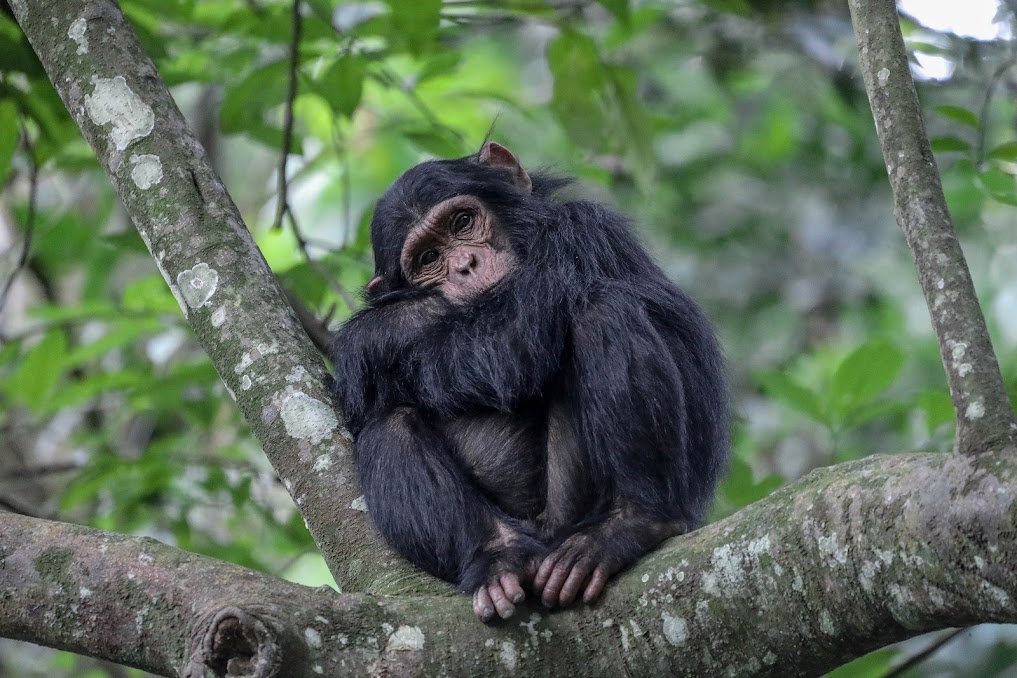
10. Chimpanzee.
Chimpanzees (Pan trolodytes) and human share about 98 percent of their DNA, than with Gorillas. A chimpanzee troop can have between 30 and 150 individuals. Chimpanzees touch each other a great deal and can even kiss when they meet. An adult Chimp often has a special friend with which is spends a lot of time.
They are among the nosiest and most intelligent of Wild Animals. They spend equal time on land and in trees. They live in grasslands, woodlands and tropical rain forests. While chimpanzees are omnivores, their favorite food is fruit, leaves and concessionary eat meat and they do most of their sleeping and feeding in trees. Chimpanzees reach maturity when they are between 11 and 13 years old, and they can live for up to 60 years. An encounter with our closest Cousin the Chimpanzee in Kibale National park is the best opportunity for one to see how closely related we are to these intelligent beings. Other places where you can find Chimpanzees Semliki, Queen Elizabeth National Park in Kyambura Gorge, Budongo, Maramagambo and Kasyoha Forests
11. Nile Crocodile.
The Nile crocodile (Crocodylus niloticus) is one of the largest living Reptile. It is one of three crocodile species found in Africa. It is also the second largest crocodile in the world; a big male can weigh over half a ton and grow to be 20 feet long. The Nile crocodile can grow up to the length of 6 meters. The Nile crocodile inhabits Murchison Falls National Park on the banks of the Nile River, around Lake Mburo and on the shores of Kazinga Channel in Queen Elizabeth National Park. Crocodiles like to stay near or in water, so it lives in swamps, estuaries, rivers and lakes. It feeds on both fish, young hippos and large land animals. It is capable of killing a lion or an adult human being. It drowns its prey first, stores it under a tree until it is decomposed for easy eating.

12. Zebras.
Uganda is home to about 3,000 Plain Zebras (Equus burchelli) named after a British explorer and naturalist William John burcell their body strips are broader. While Theories abound about Zebras and their stripes, and whether any two zebras can have the same exact stripes. Zebras are avid Grazers always in consistant search of green pastures and drink regularly, can’t go for more than three days without Water. Zebras live in small family groups with members maintaining strong bond over the years. They leave their group at the ages of one to four to join an all-male bachelor group until they are strong enough to head a family. Zebras are social enough to mix with other antelope species as they feed – which also acts as protection against the predators. Large herds of Zebras are found in Lake Mburo National Park and Kidepo National Park
There are two types of Zebras in Africa; the Gravy’s and plains both in Eastern and Southern Africa in areas of savanna and woodlands, and Uganda is one of the countries in Africa with Zebras. A female zebra called a mare becomes sexually active at the age of 2-4 years able to produce in the second year, a male which is called the stallion because sexually mature at 4 years.
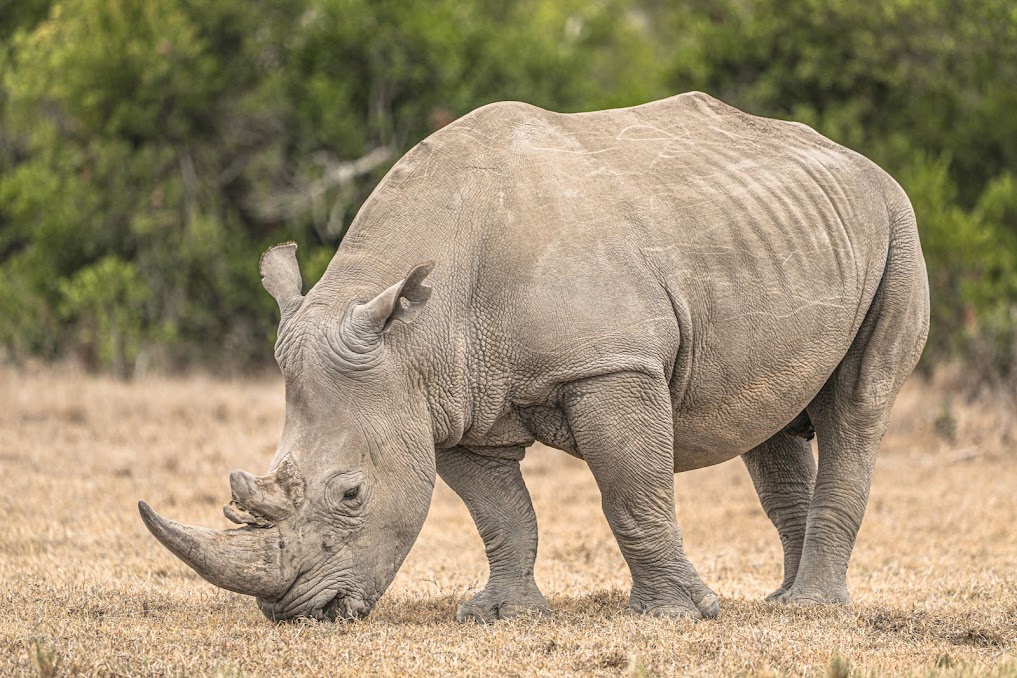
13. Rhinoceros
The Rhinoceros (Ceratotherium simum) is a large primitive looking Mammal. It is a Member of the big five. It has a Poor Eye sight, and will sometimes charge without apparent reason. It has a very good sense of smell and hearing. Rhinos mainly live alone and the closest Rhino Relationship is between a female and her calf lasting 2-4 Years. Rhinos are herbivores feeding on leaves, buds and shots of plants
Both black and white rhinoceroses are native to Uganda and both were extinct in the wild by 1982. In 2005, the Uganda Wildlife Authority worked with some other groups to establish the Ziwa Rhino Sanctuary and reintroduce the southern white rhinoceros. They started off with six animals, and those numbers have grown to 32. These with Other Uganda wildlife have made their home in the sanctuary which is the only place in Uganda where visitors may see a rhinoceros in the wild and at the Uganda Wildlife Education Centre in Entebbe.
14. Warthog
Warthog (Phacochonoerus Africanus) are neither graceful nor beautiful, however they are none the less remarkable Animals. As part of their grooming they take sand baths, rub against trees and termite mounds or let tickbirds pick insects off their bodies.
Warthogs live in Family groups of Females and her young males normally live by themselves, only joining the female groups to mate.
A Warthog is mainly a grazer and has an interesting practice of kneeling on its padded knees to eat short grass.
There are about 3,600 and can mainly be found in Lake Mburo National Park, Queen Elizabeth National Park, Murchison Falls National Park and Kafu River Basin.
15. Jackal
The Jackal (Cerus adustus) is a member of the dog Family, the Jackal looks more like a fox. The most common in Uganda is the side stripped and black backed jackal.
The Jackal usually hunts alone preferring to hunt at night, it begins its hunt at sunset and ends at sunrise. A mating Pair of jackals often stays together for years, some times for life. Male and Female jackals care for the puppies.
Jackals are scavenger and feed on the remains of dead animals but will occasionally hunt down small mammals like lizards, insects and also eat grass.
Timid and rarely seen the Side-striped Jackal is larger than the more common Black-backed Jackal. The Side-striped Jackals occupy a range of habitats, from game areas through farmland to towns within the broad-leaved savanna zones, including wooded habitats, bush, grassland, abandoned cultivation, marshes and montane habitats up to 2,700 meters.
The black stripped jackal is the most common in Uganda and occurs in Queen Elizabeth National Park, Kidepo Valley National Park, Lake Mburo National Park, Bwindi Impenetrable Park, Mgahinga National Park and is most likely to be seen in the north of Murchison Falls National Park.
16. Hyena
The spotted Hyena (Crocuta Crocuta) is thought to be timid, the Hyena can be bold and dangerous attacking animals, the female spotted hyenas are dominant over the Male. Hyenas are organized into clans of related individuals and they mark their territories by depositing a strong smelling substance along the boundaries. Their diet consists of various animals, bones, Vegetables and other animals, droppings.
Hyenas are famous for their giggling calls and their unique body shape. Uganda is home to spotted hyenas – the largest and noisiest of four hyena species in Africa mainly found in Lake Mburo National Park, Queen Elizabeth National Park as well as Mgahinga National Park.
These safari animals should be on your bucket list for a Ugandan Safari. However, they shouldn’t be the only ones. What these are, is a great start that is nowhere near enough.
17. Baboon
The Olive baboon, is the only type of baboon found in Uganda. It has been accorded full species status (Papio anubis) by some authorities and designated as a race of the yellow savanna baboon (Papio cyanocephalus) by others.
Baboons live in large troops with a complex and rigid social structure held together by matriarchal lineages. Males frequently move between troops in their search for social dominance.
Baboons are widespread and common in Uganda: they occur in all but the three montane national parks and are frequently seen on the fringes of forest reserves and even along the roadside elsewhere in the country roadsides where they wait to ambush cars in search of food. They spend more time on the ground than most other primate species, but sleep in trees at night. If water is scarce, they can survive for long periods by licking the dew from their fur.
Heavily built and mainly terrestrial, baboons can be distinguished from any other monkey found in Uganda by their larger size and distinctive dog-like head.
Baboons are omnivorous and highly adaptable, for which reason they are the most widespread primate in Africa. Four types of baboon live in sub-Saharan Africa.
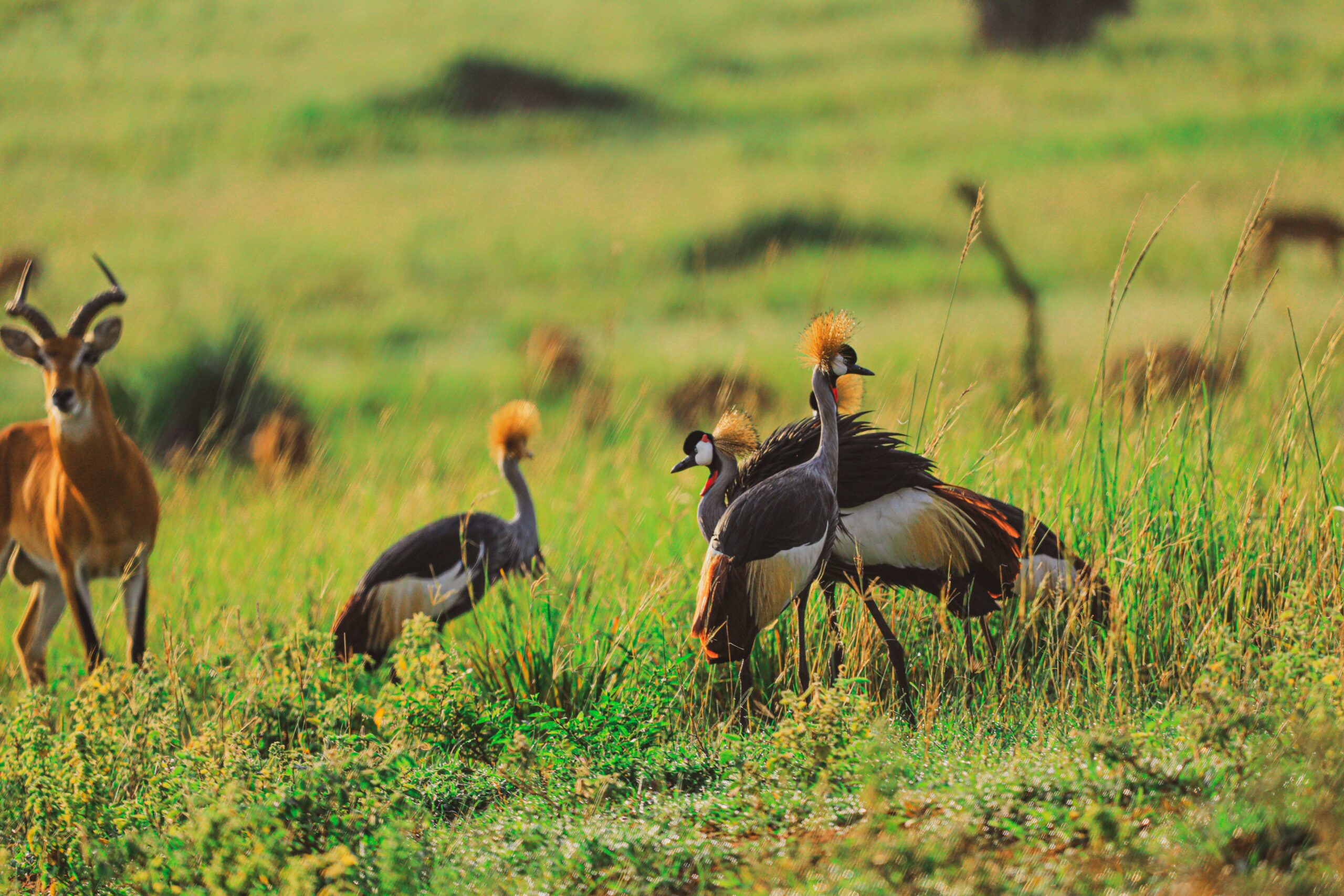
18. Grey Crowned Crane
The Grey Crowned Crane is scientifically known as Balearica regulorum gibbericeps and is the national bird of Uganda. The Crested Crane, as it is known in Uganda, was chosen as the national emblem because of its beauty and elegance and appears on the flag stepping forward with the bird on a white background, symbolizing a bright future for the country and that the country is moving forward. Its beautiful colors harmonize with the flag’s colors; Black, yellow and Red. Black symbolizing that Uganda belongs to Africa and we are proud to be part of the continent. Yellow symbolizes the abundant sun and the fresh tasty fruits, food, lush green vegetation and the golden light after twilight that is generated from the sun. Red symbolizes that we respect other people and we regard them as our brothers or sisters; we should be warm and friendly as we from all continents all have the same color of blood.
In Uganda the beautiful Grey Crowned Crane, is a permanent resident and likely to be seen during a safari or when birding in Uganda. The Grey Crowned Crane is from the same family as the Common crane but splitting orders. In most of its range the ethno-ornithology, its symbolic call which can’t be missed because of its loudness and harmonic since time in memory has been used to relate time and predict seasons for farmers and long distance travelers. Grey crowned cranes are found in Africa south of Sahara and the subspecies that is in Uganda is called crested crane. This type of crane does not migrate so they breed in Uganda and if you are lucky you might see their courtship dance.
